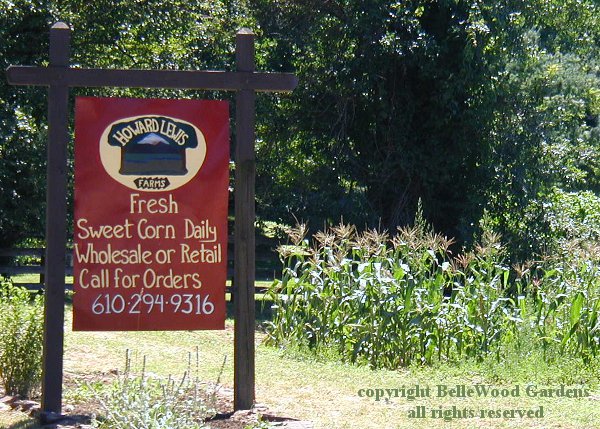
.
If you have any comments, observations, or questions about what you read here, remember you can always Contact Me
All content included on this site such as text, graphics and images is protected by U.S and international copyright law.
The compilation of all content on this site is the exclusive property of the site copyright holder.
About Corn
Saturday, 11 August 2018
It's that time of year again.

Summer comes. Year after year, we eagerly anticipate local sweet corn.
The ideal, we're told, is to put a pot of water on the stove to boil, then rush to your garden and pick some corn. From garden to cooking to table, quick as you can. These days, with super sweet hybrid corn, there is a grace period. However well traveled corn shipped up from the South is pushing things. When I was a child the first hybrid corn - Golden Bantam and Country Gentleman - was just becoming available. I remember the adults exclaiming how wonderful it was. Let me tell you about corn, possibly more than you want to know.
Also called maize, corn as we know it today was developed from teosinte, the original wild corn of Mexico. Familiar with today's big fat ears of corn, well filled with kernels, you would not recognize it, much smaller with two rows of 5 to 10 kernels, and each kernel having its own husk.

image from Wiki Commons
Teosinte, Zea mays ssp. parviglumis growing wild in Jalisco state, Mexico
The earliest physical evidence for cultivated maize dates back at least 8,700 calendar years ago. It was probably domesticated by indigenous peoples in the lowland areas of southwestern Mexico. Suppression of branching from the stalk resulted in a lower number of ears per plant but allowed each ear to grow larger. The hard case around the kernel disappeared over time. Today, maize has just a few ears of corn growing on one unbranched stalk.
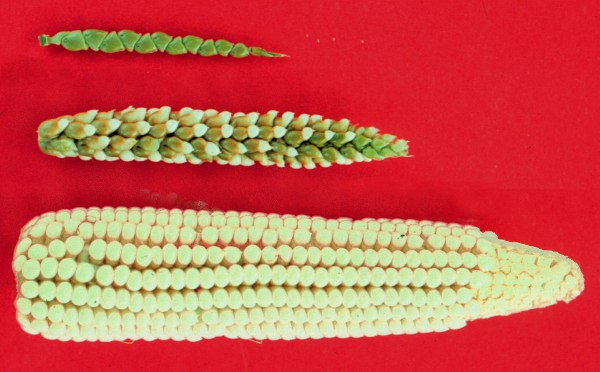
image John Doebley, http://teosinte.wisc.edu/Zea mays ssp mexicana images.html
from top: teosinte, back cross of modern corn & teosinte, modern corn
From Mexico maize spread southward down the coast to Peru, and northward into what is now the Southwestern United States. Around 2100 BCE people began to eat very differently in North America. The Pueblo people began to farm.
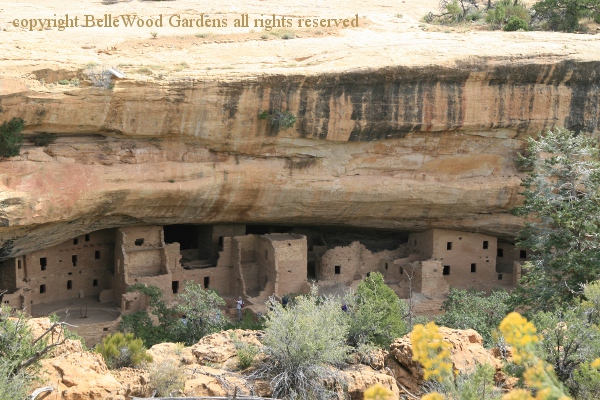
Spruce Tree House at Mesa Verde in Colorado
At Mesa Verde, the people lived below and farmed on top of the mesa, coping with short growing seasons, arid climate, and frequent drought. They obtained seed of corn and beans and squash from the pre-Olmec people of Mexico and began to eat these three cultivated crops as well as foraged wild foods. The first type of corn that they grew was a popcorn variety with a cob only about one or two inches long. The corn kernels were ground into corn meal using mortars and pestles made from stone or wood, and made into a flat bread, like modern tacos and tortillas. Mashed pinto beans were rolled up inside these wrappers, then eaten. Corn and beans, eaten together, are a complete food containing an adequate proportion of each of the nine essential amino acids necessary in our diet. Even today, pinto beans are dry farmed in semi-arid fields.
As people migrated north to the eastern woodlands of present day New England they brought corn with them. Which explains how, after the Mayflower landed the Pilgrims on the western coast of Cape Cod Bay in 1620, Tisquantum (known by the diminutive Squanto) taught them how to grow the native Three Sisters crops of corn, beans, and winter squash. It was difficult, and not merely because the crops were unfamiliar. The Pilgrims were used to growing crops in rows. This worked well with the soils and conditions of their homeland. Wampanoag grew corn, squash, and beans in a companion planting mound system that was successful with the sandy soil that doesn't retain nutrients or water as well as loam.
Wampanoag planted using flat-topped mounds of soil about 12 inches high and 20 inches across for each "family" of the mixed planting. Small, somewhat rotten fish buried as fertilizer in the mound as the corn seed was planted. As an aside - we still use fish fertilizer today, only in liquid form. They also used wood ash, which contains potassium, some phosphorus, and also calcium which acts as a liming agent to counteract the lower pH typical of the region's soils. When the corn was 6 inches tall, beans and squash would be alternately planted around it. This is actually a very sophisticated technique, developed over millenia. Corn provides a support for the beans to climb. Nodules on the bean roots contain microorganisms that fix atmospheric nitrogen, turning into fertilizer. And the large squash leaves shade the soil which helps retain moisture while also crowding out weeds.
Nor is the planting technique the only benefit. Corn, beans, and squash contain complex carbohydrates, essential fatty acids and all of the essential amino acids, so the Native American tribes could thrive on a plant-based diet. Moreover, corn and beans can be dried for long term storage, while winter squash with their hard rind are also good keepers.
There are several types of corn. The big three most popular here in the United States are field or dent corn, sweet corn, and popcorn. Dent corn, Zea mays indentata, has a tiny dent in the top of each kernel when dried. It has a very starchy, bland flavor, mealy texture and today we use it mostly as animal feed, making high fructose corn syrup, or ethanol. Probably accounts for better than 90% of our corn production.
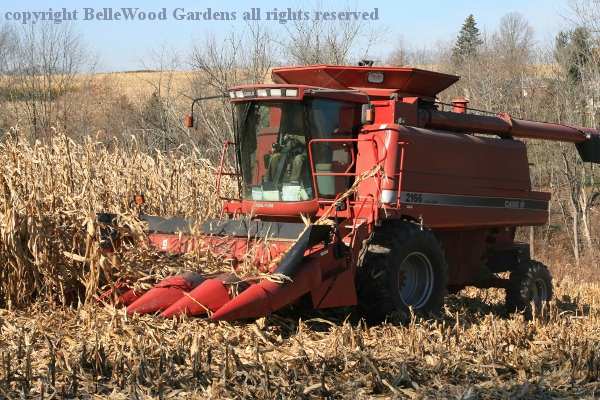
Mechanically harvesting a small field of corn at the end of my road.
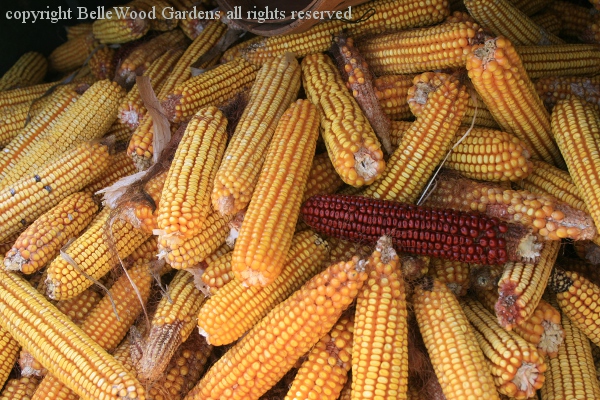
Harvested field corn at Howell Living History Farm in Mercer County, New Jersey.
Flint corn, which has a hard outer skin, has similar uses to dent corn but isn't as popular in North America. It is grown in Central and South America as a feed and food source. The type of corn preferred for making hominy, a staple food in the Americas since pre-Columbian times, flint corn was one of the three types of corn cultivated by Native Americans, both in New England and across the northern tier of states, including by tribes such as the Pawnee on the Great Plains. The corn grown by the early settlers at Plymouth was the Northern Flint variety, with delicate kernels that are unsuitable for popping. With less soft starch than dent corn, flint corn lacks the dents in each kernel from which dent corn gets its name.

A handful of stone ground corn meal at the grist mill at historic
Walnford, a Monmouth county, New Jersey state park.
Stone-ground between two stones, the texture is coarser than commercially milled with steel rollers because the hull and germ of the corn kernel remain. This means that usually there is a more noticeable "corn" flavor, and the meal is also is more perishable. I store mine in the freezer to keep it from going rancid. The difference between white and yellow corn meal just depends on the color of the kernels from which it is ground.
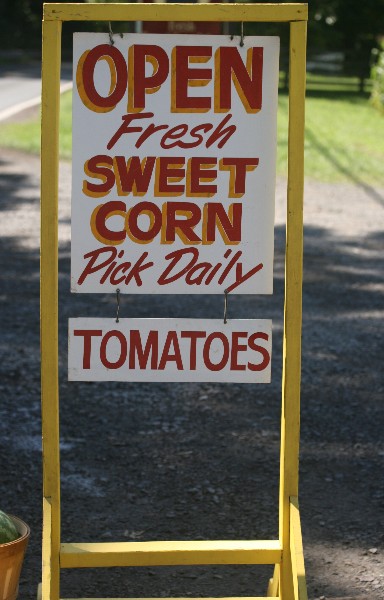
But what most of us want is sweet, fresh corn just picked from the field.
It was early in the 20th century that hybrid sweet corn was developed. Before then, in summer people ate "green" immature field corn. Hybridizing corn was difficult. Open pollinated corn, even prize winners from fairs and grange competitions, do not pass on their vigor and larger size ears. Wind pollinated, there is no control of the male parentage. For breeding purposes the tassels at the top of each corn plant needed to be removed before the silks on every ear become receptive. Even today home gardeners are advised to keep different varieties of corn 400 or more yards apart, or plant varieties that tassel 2 weeks apart.
Beginning in 1914 when he arrived at the Connecticut Experiment Station, Donald Jones created a double cross hybrid corn using four distinct inbred lines and breeding two separate hybrids plants. His theory was that heterosis, hybrid vigor, would produce the desired traits. The resulting plants were more vigorous, hardier, larger. But the improvements were lost over subsequent inbred generations. It is the first generation hybrids that have the valuable results. Seed companies kept the parent strains and sold seed of the F1 cross, which produce the wanted crop results. However seed saved by farmers would be less useful for continued propagation in subsequent years.
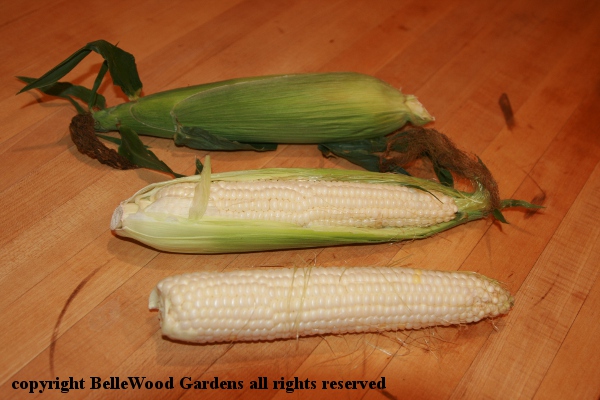
Corn as it is today cannot survive without us. The husks are too thick, have
too many layers for seed to reach the ground. How fortunate for corn
that it is so useful both as a food source and a foundation for producing
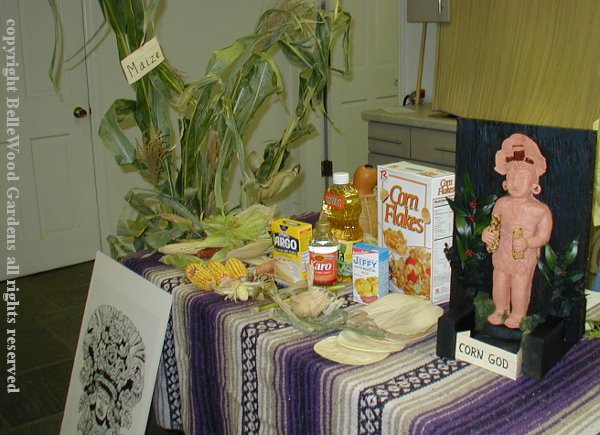
corn starch, corn meal, and corn flakes, corn oil, high fructose corn syrup.
Corn whiskey, ethanol, and others you have probably never thought of.
One more thing.
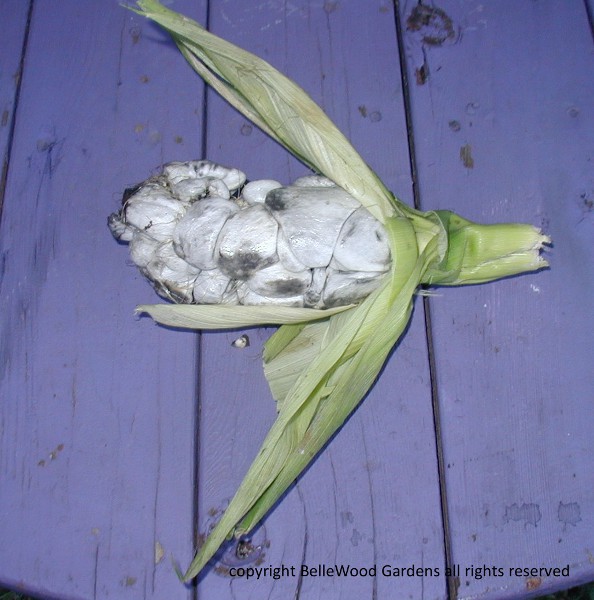
This isn't something alien from outer space. This is corn smut.
It's a fungus that entered the corn stalk and infected the kernels.
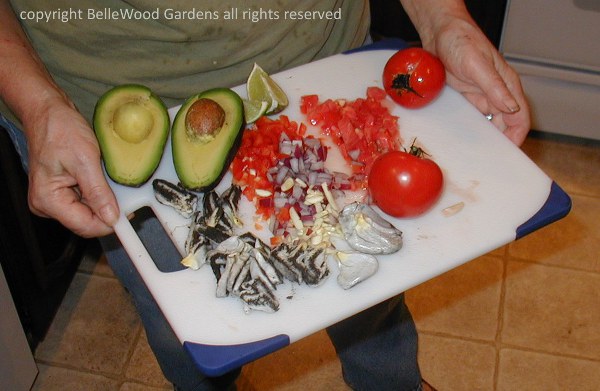
In Mexico it is called huitlacoche. And it is delicious when cooked.
I've eaten and enjoyed huitlacoche several times. Modern cultivars
are resistant. 'Silver Queen' an older variety, is more susceptible.
So there you have it. About corn, perhaps more than you wanted to know.
Back to Top
Back to August 2018
Back to the main Diary Page